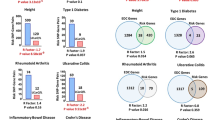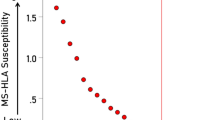Abstract
TNFRSF6B and TNFRSF14 genes were recently associated with Crohn's disease and rheumatoid arthritis. TNFRSF14 is known as herpes virus entry mediator (HVEM), and herpes viruses have been involved in the aetiology of multiple sclerosis (MS). MS patients present human herpes virus 6 (HHV6) in active plaques and increased antibody responses to HHV6. We aimed to ascertain the role of these genes in MS susceptibility and to investigate the relationship of the gene encoding the widely expressed HVEM receptor with the active replication of HHV6 found in some MS patients. Genotyping of 1370 Spanish MS patients and 1715 ethnically matched controls was performed. HHV6A DNA levels (surrogate of active viral replication) were analysed in serum of MS patients during a 2-year follow-up. Both polymorphisms were associated with MS predisposition, with stronger effect in patients with HHV6 active replication—TNFRSF6B-rs4809330*A: P=0.028, OR=1.13; TNFRSF14-rs6684865*A: overall P=0.0008, OR=1.2; and HHV6-positive patients vs controls: P=0.017, OR=1.69.
This is a preview of subscription content, access via your institution
Access options
Subscribe to this journal
Receive 6 digital issues and online access to articles
$119.00 per year
only $19.83 per issue
Buy this article
- Purchase on Springer Link
- Instant access to full article PDF
Prices may be subject to local taxes which are calculated during checkout
Similar content being viewed by others
References
Mallett S, Barclay AN . A new superfamily of cell surface proteins related to the nerve growth factor receptor. Immunol Today 1991; 12: 220–223.
Kugathasan S, Baldassano RN, Bradfield JP, Sleiman PM, Imielinski M, Guthery SL et al. Loci on 20q13 and 21q22 are associated with pediatric-onset inflammatory bowel disease. Nat Genet 2008; 40: 1211–1215.
Fayad R, Brand MI, Stone D, Keshavarzian A, Qiao L . Apoptosis resistance in ulcerative colitis: high expression of decoy receptors by lamina propria T cells. Eur J Immunol 2005; 36: 2215–2222.
Kim S, Fotiadu A, Kotoula V . Increased expression of soluble decoy receptor 3 in acutely inflamed intestinal epithelia. Clin Immunol 2005; 115: 286–294.
The Wellcome Trust Case-Control Consortium. Genome-wide association study of 14 000 cases of seven common diseases and 3000 shared controls. Nature 2007; 447: 661–678.
Raychaudhuri S, Remmers EF, Lee AT, Lee AT, Hackett R, Guiducci C et al. Common variants at CD40 and other loci confer risk of rheumatoid arthritis. Nat Genet 2008; 40: 1216–1223.
Barton A, Thomson W, Ke X, Eyre S, Hinks A, Bowes J et al. Rheumatoid arthritis susceptibility loci at chromosomes 10p15, 12q13 and 22q13. Nat Genet 2008; 40: 1156–1159.
Christensen T . Human herpesviruses in MS. Int MS J 2007; 14: 41–47.
Santoro F, Kennedy PE, Locatelli G, Malnati MS, Berger EA, Lusso P . CD46 is a cellular receptor for human herpesvirus 6. Cell 1999; 99: 817–827.
Mori Y, Yang X, Akkapaiboon P, Okuno T, Yamanishi K . Human herpesvirus 6 variant A glycoprotein H-glycoprotein L-glycoprotein Q complex associates with human CD46. J Virol 2003; 77: 4992–4999.
Tang H, Kawabata A, Takemoto M, Yamanishi K, Mori Y . Human herpesvirus-6 infection induces the reorganization of membrane microdomains in target cells, which are required for virus entry. Virology 2008; 378: 265–271.
Knox KK, Brewer JH, Henry JM, Harrington DJ, Carrigan DR . Human herpesvirus 6 and multiple sclerosis: systemic active infections in patients with early disease. Clin Infect Dis 2000; 31: 894–903.
Soldan SS, Berti R, Salem N, Secchiero P, Flamand L, Calabresi PA et al. Association of human herpes virus 6 (HHV-6) with multiple sclerosis: increased IgM response to HHV-6 early antigen and detection of serum HHV-6 DNA. Nat Med 1997; 3: 1394–1397.
Rosche B, Cepok S, Stei S, Vogel F, Grummel V, Hoffmann S et al. The role of the polio virus receptor and the herpesvirus entry mediator B genes for the development of MS. J Neuroimmunol 2004; 156: 171–177.
Schmidt S, Pericak-Vance MA, Sawcer S, Barcellos LF, Hart J, Sims J et al. Allelic association of sequence variants in the herpes virus entry mediator-B gene (PVRL2) with the severity of multiple sclerosis. Genes Immun 2006; 7: 384–392.
Heap GA, Van Heel DA . The genetics of chronic inflammatory diseases. Hum Mol Genet 2009; 18: R101–R106.
Remmers EF, Plenge RM, Lee AT, Graham RR, Hom G, Behrens TW et al. STAT4 and the risk of rheumatoid arthritis and systemic lupus erythematosus. N Engl J Med 2007; 357: 977–986.
Smyth DJ, Plagnol V, Walker NM, Cooper JD, Downes K, Yang JH et al. Shared and distinct genetic variants in type 1 diabetes and celiac disease. N Engl J Med 2008; 359: 2767–2777.
The Australia and New Zealand Multiple Sclerosis Genetics Consortium (ANZgene). Genome-wide association study identifies new multiple sclerosis susceptibility loci on chromosomes 12 and 20. Nat Genet 2009; 41: 824–828.
Kawasaki M, Sekigawa I, Nozawa K, Kaneko H, Takasaki Y, Takamori K et al. Changes in the gene expression of peripheral blood mononuclear cells during the menstrual cycle of females is associated with a gender bias in the incidence of systemic lupus erythematosus. Clin Exp Rheumatol 2009; 27: 260–266.
Hafler DA, Compston A, Sawcer S, Lander ES, Daly MJ, De Jager PL et al. Risk alleles for multiple sclerosis identified by a genomewide study. N Engl J Med 2007; 357: 851–862.
Burton PR, Clayton DG, Cardon LR, Craddock N, Deloukas P, Ducanson A et al. Association scan of 14 500 nonsynonymous SNPs in four diseases identifies autoimmunity variants. Nat Genet 2007; 39: 1329–1337.
Zhang S, Sha Q, Chen HS, Dong J, Jiang R . Transmission/disequilibrium test based on haplotype sharing for tightly linked markers. Am J Hum Genet 2003; 73: 566–579.
Clayton D, Jones H . Transmission/disequilibrium tests for extended marker haplotypes. Am J Hum Genet 1999; 65: 1161–1169.
Fogdell-Hahn A, Soldan SS, Jacobson S . Association of chronic progressive neurological disease and ubiquitous viral agents: lessons from human herpesvirus 6 and multiple sclerosis. Mol Psychiatry 2002; 7: S29–S31.
Fotheringham J, Jacobson S . Human herpesvirus 6 and multiple sclerosis: potential mechanisms for virus-induced disease. Herpes 2005; 12: 4–9.
Simmons A . Herpesvirus and multiple sclerosis. Herpes 2001; 8: 60–63.
Akhyani N, Berti R, Brennan MB, Soldan SS, Eaton JM, McFarland HF et al. Tissue distribution and variant characterization of human herpesvirus (HHV)-6: increased prevalence of HHV-6A in patients with multiple sclerosis. J Infect Dis 2000; 182: 1321–1325.
Berti R, Brennan MB, Soldan SS, Ohayon JM, Casareto L, McFarland HF et al. Increased detection of serum HHV-6 DNA sequences during multiple sclerosis (MS) exacerbations and correlation with parameters of MS disease progression. J Neurovirol 2002; 8: 250–256.
Alvarez-Lafuente R, De las Heras V, Bartolome M, Picazo JJ, Arroyo R . Relapsing-remitting multiple sclerosis and human herpesvirus 6 active infection. Arch Neurol 2004; 61: 1523–1527.
Poser CM, Paty DW, Scheinberg L, McDonald WI, Davis FA, Ebers GC et al. New diagnostic criteria for multiple sclerosis: guidelines for research protocols. Ann Neurol 1983; 13: 227–231.
Alcina A, Fedetz M, Ndagire D, Fernández O, Leyva L, Guerrero M et al. IL2RA/CD25 gene polymorphisms: uneven association with multiple sclerosis (MS) and type 1 diabetes (T1D). PLoS One 2009; 4: e4137.
Urcelay E, Blanco-Kelly F, de Las Heras V, de la Concha EG, Arroyo R, Martinez A . TLR4 haplotypes in multiple sclerosis: a case-control study in the Spanish population. J Neuroimmunol 2007; 192: 215–218.
Hymas W, Stevenson J, Taggart EW, Hillyard D . Use of lyophilized standards for the calibration of a newly developed real time PCR assay for human herpes type six (HHV6) variants A and B. J Virol Methods 2005; 128: 143–150.
Nitsche A, Muller CW, Radonic A, Landt O, Ellerbrok H, Pauli G et al. Human herpesvirus 6A DNA is detected frequently in plasma but rarely in peripheral blood leukocytes of patients after bone marrow transplantation. J Infect Dis 2001; 183: 130–133.
Acknowledgements
The authors thank Carmen Martínez and M Angel García for their skilful technical assistance. Roberto Alvarez-Lafuente is recipient of a research contract from ‘Fondo de Investigaciones Sanitarias’ (CP07/00273) and Elena Urcelay works for the Fundación para la Investigación Biomédica-Hospital Clínico San Carlos. This work was supported by grants from: Alfonso Martín Escudero Foundation, Fondos Europeos de Desarrollo Regional (FEDER) and Ministerio de Ciencia e Innovación (SAF2006-02023, SAF2009-11491), Junta de Andalucía (P07-CVI-02551), Servicio Andaluz de Salud (PI0168/2007), Plan Andaluz P08-TIC-03717 and Fondo Investigaciones Sanitarias FIS PI07/0353, PI08/1636 and RETICS 2007 (REEM). We acknowledge the International Multiple Sclerosis Genetics Consortium (IMSGC) and the Wellcome Trust Case-Control Consortium (WTCCC) for sharing their data repository.
Author information
Authors and Affiliations
Corresponding author
Ethics declarations
Competing interests
The authors declare no conflict of interest.
Additional information
Supplementary Information accompanies the paper on Genes and Immunity website
Rights and permissions
About this article
Cite this article
Blanco-Kelly, F., Alvarez-Lafuente, R., Alcina, A. et al. Members 6B and 14 of the TNF receptor superfamily in multiple sclerosis predisposition. Genes Immun 12, 145–148 (2011). https://doi.org/10.1038/gene.2010.42
Received:
Revised:
Accepted:
Published:
Issue Date:
DOI: https://doi.org/10.1038/gene.2010.42
Keywords
This article is cited by
-
Human herpesvirus 6 infection as a trigger of multiple sclerosis: an update of recent literature
BMC Neurology (2022)
-
Associations between CD160 polymorphisms and autoimmune thyroid disease: a case-control study
BMC Endocrine Disorders (2021)
-
Classification of HHV-6A and HHV-6B as distinct viruses
Archives of Virology (2014)



